Excerpts from Jim Conrad's
Naturalist Newsletter






from the May 9, 2010 Newsletter issued from Hacienda Chichen Resort beside Chichén Itzá Ruins, central Yucatán, MÉXICO
LEAFCUTTER ANT VIDEO
Late Tuesday afternoon a line of leafcutter ants formed alongside my hut, many carrying leaf shreds they'd cut from some unfortunate plant. The line led to a fallen, leafing-out but wilting Gumbolimbo branch knocked off by high winds about three days earlier. Maybe you can see them below:
from the September 5, 2010 Newsletter issued from Hacienda Chichen Resort beside Chichén Itzá Ruins, central Yucatán, MÉXICO
LEAFCUTTER ANTS EAT MY CHAYA
The edible-leafed Chaya in front of the hut has had a hard time. Within a week of my planting it caterpillars completely defoliated it. About a month after new leaves had been issued, leafcutter ants attacked, carrying away about half the leaves before mysteriously moving on to other plants. This week the leafcutters returned, and this time they completely defoliated it again.
Leafcutters cut away small sections of many kinds of leaves, carry the tatters back to their cavernous subterranean nest -- these ants' nest lies about fifty feet away (15 m) -- where the tatters are added to masses of other leaf tatters, and then a certain kind of fungus starts growing on the leaf-masses. The ants will feed on the fungus, not the leaves.
You can see an ant excising a section of Chaya leaf below:
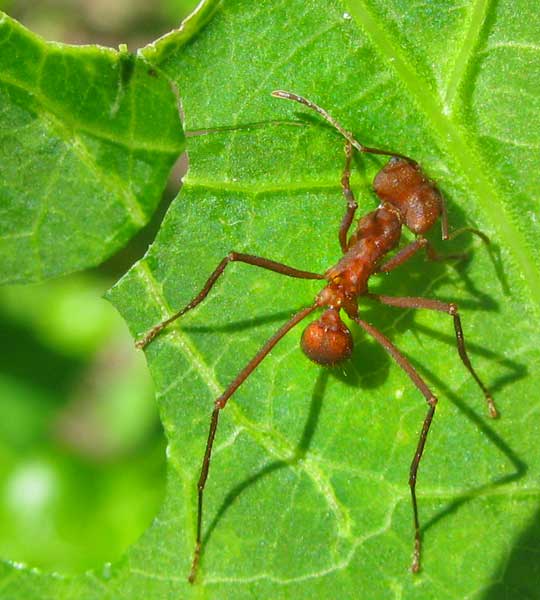
A close-up showing how the spiny-backed ant holds his fuzzy head at an angle in order for his sharp mandibles to be in a better slicing position is shown next:
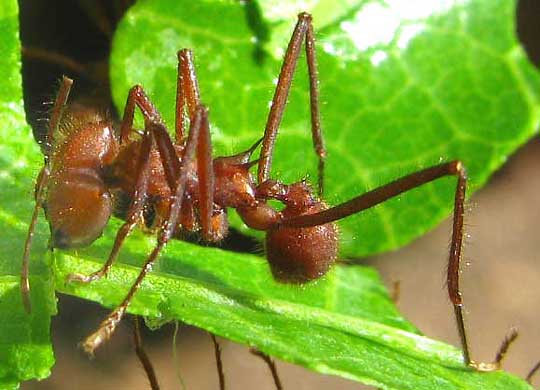
That last picture is worth studying. For one thing, it shows an ant cutting away the very platform on which she is standing, plus there's another ant beneath her holding to the same leaf section, that is about to be cut loose.
In fact, as I watched individual leafcutters reduce my poor Chaya to tatters, several times I saw ants cut away the parts of the leaf they were standing on. Usually they gradually moved onto the remaining part of the leaf, or at least managed to grab hold of the main leaf body before they fell, but sometimes they, along with their leaf tatter, plummeted to the ground. Sometimes the ant remained on the parent leaf while only the tatter fell. Sometimes the ground below the Chaya was almost green with fallen, unattended tatters, but as night fell ants began clearing the ground of dropped pieces, and carrying them away.
During these defoliations, if you watch a series of individual ants at work, you'll probably get the notion that they're a disorganized bunch. Often you see ants carrying tatters the wrong way, returning to the nest carrying nothing, or maybe just wandering around bumping into other ants, not seeming to accomplish anything constructive. Yet, at the end of the day, it's impressive just how much they've cut and carried away.
The continually flowing line of tatter-carrying leafcutters passes right below the green, immature Black Iguana I introduced you to last week, perched on his little rock. That iguana lets thousands and thousands of leafcutter ants pass less than a foot below his nose, but the moment a grasshopper or butterfly lands within twenty feet, like a streak he's off. I suppose it's the formic acid in the leafcutters that makes them unpalatable. However, the other day I did see a Peacock walking along a row of leafcutters crossing a corner of a parking lot just outside the ruin's entrance, and that bird nonchalantly pecked up quite a few.
A couple of days before the leafcutters attacked my Chaya they'd started on the basil planted beside my door. I happened to be sitting there just as the defoliation began. In a spray bottle I had a small bit of solution made from mashed garlic and Common Rue, which earlier had seemed to keep caterpillars off my cucumber plants. I sprayed the basil with what was left of that and the ants immediately stopped their predation. The unfortunate thing is that I have no more garlic or Rue for making a spray.
Having leafcutters so handy, I've been able to study what they do when it rains. From what I've seen, they don't do much of anything. If the rain isn't hard, they work through it. If it's a heavy rain, eventually they drop their tatters and hold onto something or get beneath something. I think a lot must drown. Within half an hour of the rain's end, individual ants start appearing on the old trail, some with tatters, and start back toward the nest. If a big puddle lies between them and their nest, they reach the water's edge, drop their tatters, and wander around until something happens. The tatters build up. Here puddles never last long, so within an hour or so they do reach their nest and all the tatters have disappeared.
During the dry season the leafcutters tended to work at night and disappeared during most of the day. Nowadays they work during the day and seem to quit with darkness.
What curious, mysterious things these leafcutters are. Really I understand why there's a discussion about whether the "leafcutter organism" is the individual leafcutter ant, or rather the whole nest -- individual ants analogous to red corpuscles flowing along arteries defined by scents on the ground. Information flows from the brain (the queen) not along neurons, but via chemicals passed from one ant to another. Who says that a living body can't be diffuse, and must be wet?
And if we can accept that an ant colony might constitute a single living organism, then there's Gaia to think about, and the Universal Unity...
from the June 21, 2015 Newsletter issued from Río Lagartos, on the north-central coast of Yucatán, MÉXICO
BIG-BOTTOMED FLYING ANTS
Last weekend our dry season definitely ended with a downpour lasting much of the day, which flooded streets, dribbled through many folks' ceilings, and left standing water in many of the lagoons that for the last few weeks have been hard-baked dry. Therefore, I wasn't surprised -- in fact was delighted -- to find the large, amber-colored, waspish insect floating alive in a pool of water shown drying on my hand below:
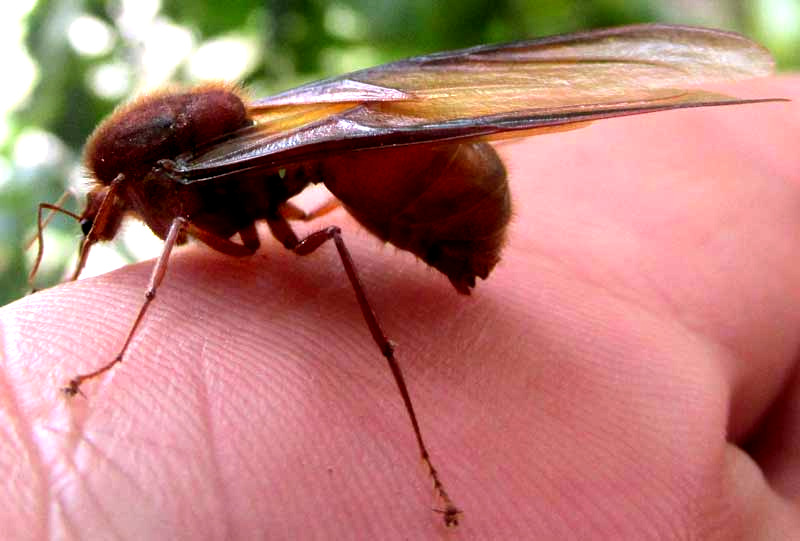
I was delighted because in much of the humid American tropics this is exactly what you look for below artificial lights -- which stood above the pool of water -- soon after the dry season's first big rain. We first met this kind of critter after the first big rain in June, when we were in upland Querétaro in 2007, where we learned that many country folks in the Americas roast and eat these insects. You can read that interesting entry at www.backyardnature.net/q/culonas.htm.
Then, once again in June, after the big Memorial Day rain in drought-striken southwestern Texas last year, we saw them en masse, as illustrated and described at the bottom of our Texas Leafcutter Ant Page at www.backyardnature.net/n/a/leaf-cut.htm.
So, yes, these are leafcutter ants, the same ants you see so often in the American tropics in long lines, with individual ants carrying cut-out leaf sections or parts of a flower, or something like that, above their heads, to be deposited in the colony's underground chamber. There a fungus will grow on the subterranean compost heap, and the ants will eat the fungus, not the compost.
But, the big, winged ant pictured on my hand isn't a leafcutter ant worker, which is what we see carrying shreds of vegetation to underground chambers. It's a drone or "male alate," very much larger than wingless, sterile worker ants. Our first big rain of the rainy season has been the signal for our local leafcutter-ant colonies to issue virgin queens and hoards of drones to mate with the queens. The queens and drones emerge at night and are attracted/distracted by artificial lights. On our Texas Leafcutter Ant Page linked to above you'll see that we were lucky enough to photograph a queen as well as a drone, and even an attempt at mating.
Seventeen leafcutter ant species of the genus Atta are recognized. The Texas species was Atta texana. The one in Querétaro in north-central Mexico had been Atta mexicana, and now here in the Yucatan we have ATTA CEPHALOTES, whose distribution map can be seen on the Antwiki.Org Atta cephalotes page.
A close-up of our ant's head, with much-reduced mouthparts, is shown below:
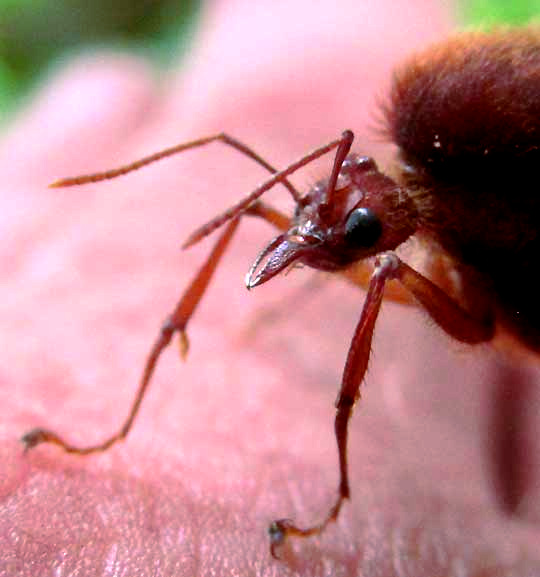
For identification purposes, our Yucatan drone's wing venation was photographed, as seen below:
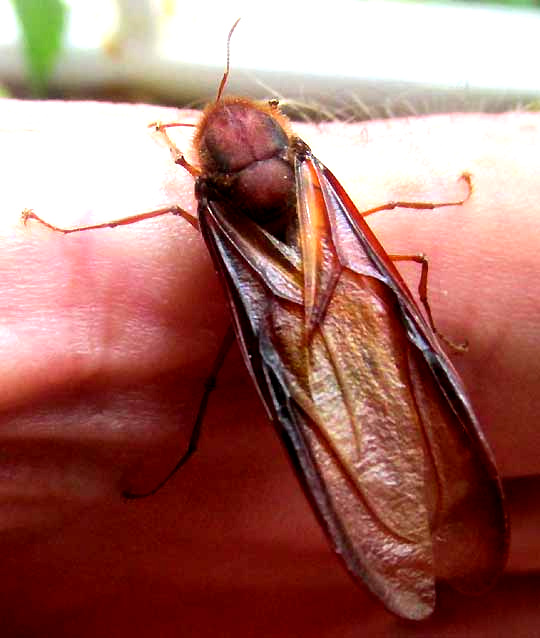
Wikipedia offers an exceptionally good page on this species, at https://en.wikipedia.org/wiki/Atta_cephalotes.
There the mating process of the queen and drones is described: "The process starts with the queen flying up off the ground. The male will then join her and inseminate her, at which point he is no longer needed and dies."
"No longer needed and dies... " This is exactly what we have seen in several places now -- lots of dying males who have done their duty, or at least tried to, or at least wanted to very badly, and are "no longer needed," and we find them dying, en masse.
Had I not been a vegetarian, I'd have at least tried to put these drones' protein to good use, by roasting and crunching through my share of the bounty.
from the January 17, 2010 Newsletter issued from Hacienda Chichen Resort beside Chichén Itzá Ruins, central Yucatán, MÉXICO
RETURN OF THE LEAFCUTTER ANTS
The owners of Hacienda Chichen are proud of their pro-environment policies, which includes using as few chemicals as possible. The other day a worker not yet clear about the policy poisoned a large leafcutter nest because the ants had begun defoliating a Tropical Almond tree in the parking lot. As soon as we saw what had been done we made every effort to scoop all the poison and contaminated soil into plastic bags and dispose of the bags properly.
Before the poisoning attempt, every day I'd seen the ants carrying bits of herbage back to their nest. However, after the poisoning for two weeks not a single ant was seen at the nest. I felt sure that the whole colony had been wiped out. It had been a colony as large as the one we saw last year at Yokdzenot. You still can read about that big nest and see it lower in the page.
Wednesday morning, there were ants again. Moreover, not only had the colony resumed its earlier foraging habits, but also they seemed to have redoubled their efforts, for now many more ants than before were carrying cut-out leaf sections and they were moving faster. Anthropomorphically, they looked exactly as if they were trying to make up for lost time! You can see several on the trunk of a Gumbo-Limbo -- which after two days they'd defoliated nearly completely -- below:
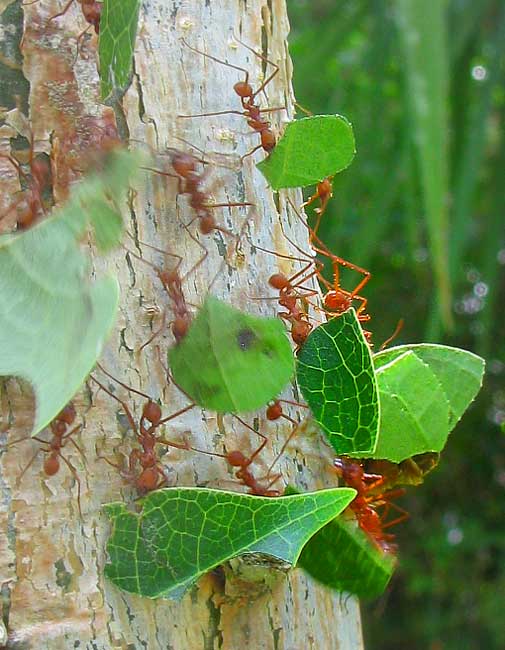
That picture was made about 30 yards or meters from their nest and every inch of the trail between there and the nest was just as cluttered and bustling with leaf-carrying ants as in the picture.
Of course I'm relieved that the nest seems to have survived. Sometimes visitors say that for them watching the ants is as fascinating as visiting the ruins! Also the experience has reminded me how like a single living organism an ant colony is. The colony became sick, stopped functioning, but then one day finally burst from home looking as healthy as ever, trying to make up for lost time. In fact, they're out there as I type this, a long, long line of them, gradually defoliating a hibiscus.
from the December 19, 2004 Newsletter issued from Hacienda Komchen near Dzemul, Yucatan, MÉXICO
LEAFCUTTER ANTS
The other night I was sitting at the edge of one of the fishponds when something small and pale showed up moving along the pond's edge. When I got on my hands and knees I saw that the pale thing was a small flower being carried by a somewhat larger, black ant. Moreover, behind this ant and flower came another ant and flower, and behind that another, and another, and another...
I knew we had leafcutter ants here because each night all the new leaves of our Tropical Almond trees were being removed, just the way leafcutter ants do. To save the trees Ana María had erected barriers around each tree's trunk, atop which she positioned rags soaked in used motor-oil.
Leafcutter ants normally work at night and they can defoliate an entire tree the size of a mature apple tree in one attack. An ant goes to a leaf and with its mandibles cuts out a leaf section -- or nips off a flower or other object of appropriate size -- then carries it back to its nest. At the nest the carried- back material is stored in subterranean chambers, where a special kind of fungus is allowed to grow on it. Ultimately the ants eat that fungus. The ants don't eat the material they carry back, just the fungus.
When I worked as a naturalist in a "jungle lodge" in Belize I got to know leafcutter ants very well. I'd take tourists on flashlight-carrying night-walks through the forest, and usually the highlight of each walk was watching the long lines of leafcutter ants carrying their booty home. It was easy to follow the ants to their nests, and sometimes the nest's excavated dirt would occupy a surface area the size of a car.
My main experience with leafcutter ants in Belize was with a leafy crop of collards-like Bok Choy I grew there. With enormous effort I cleared away the weeds, pulled up ridges, sowed, and assiduously watered my Bok Choy until I got a crop pretty enough to appear on a seed-catalogue's cover. But, then, just as the plants were getting large enough to be eaten, one night a tourist came asking what kind of ants those were carrying little green umbrellas from the direction of my garden. The next morning there wasn't a single leaf of Bok Choy remaining.
I'm not really sure how to garden in a world with leafcutter ants. My approach now is just to plant a lot of stuff and hope the ants don't like some of it. They clearly have their favorite foods, and I'm banking on their favorites not including the squash, peppers, tomatoes and herbs I've planted.
from the November 3, 2008 Newsletter issued from Yokdzenot, Yucatan, MÉXICO
LEAFCUTTER-ANT CITY
Frequently I've discussed leafcutter ants but I don't think I've commented on their large mound complexes, as below:
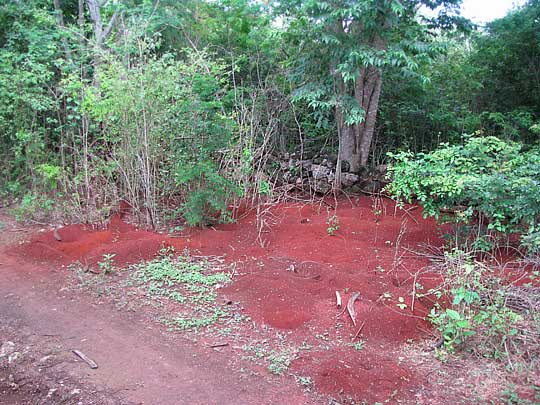
All that red dirt, about 20 feet across, has been excavated from ant tunnels below, so you can imagine the extent of the tunnels and the size of the chambers where they store their leaf tatters, on which fungus lives, which the ants eat. The complex in the picture occurs along a trail I frequently travel. Many entry tunnels occur throughout the complex, as shown below:
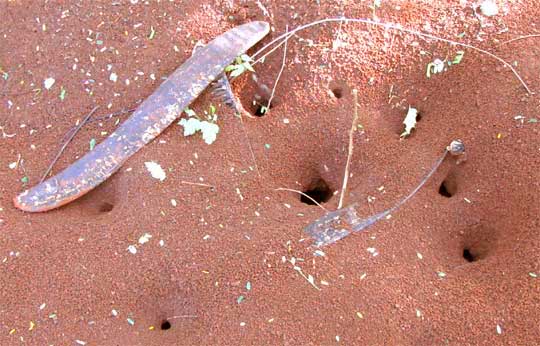
The faded, 18-inch long (45 cm) legume at the top, left is from the big Royal Poinciana tree above it.
During the day sometimes you see one or two leafcutter ants wandering atop the complex, sometimes carrying leaf segments above themselves, but leafcutter ants work mainly at night. Back when I led night-walk nature hikes in Belize the trail passed by a complex similar to this. Tourists were often more fascinated by the long ant-trails, which they followed for hundreds of feet with flashlights, more than anything else on the walk.
from the September 18, 2016 Newsletter issued from Rancho Regenesis near Ek Balam ruins, Yucatan, MÉXICO
LEAFCUTTER-ANT GUARD
Leafcutter ants were defoliating an important Neem tree, so Juan cut the top and bottom from a plastic, 20-liter, purified-water jug, slit the resulting cylinder down the side so that the cylinder could be opened up to receive the Neem's trunk, set the cylinder around the trunk, and the system kept out the leafcutters. You can see how it looked below:
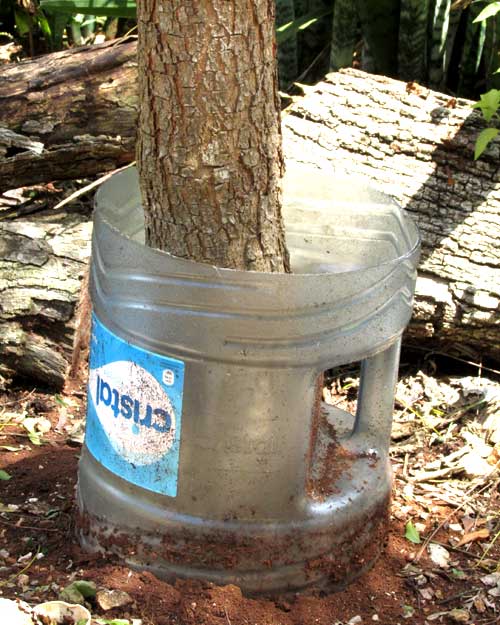
from the January 18, 2019 Newsletter issued from Rancho Regenesis in the woods ±4kms west of Ek Balam Ruins; elevation ~40m (~130 ft), N20.876°, W88.170°; north-central Yucatán, MÉXICO
JUAN'S TOOTH-ACHE AND LEAF-CUTTER ANT MUD
The paste made of three medicinal plants to ease Juan's toothache should be used when freshly made, but sometimes you just don't have the time to go pick the leaves and mash them up several times a day. When you're in that situation, you can do this:
Go find a mound of dirt piled up by leafcutter ants. Above, we see a large city of mounds. Here our mounds are smaller and appear alone, such as the one along my jogging trail shown below:
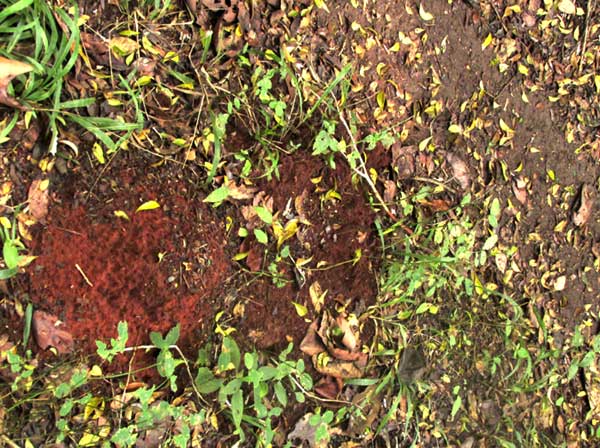
Though the surrounding ground in that picture is hard-packed clay derived from limestone rock right below the soil's surface, the mound consists of tiny, dry crumbs removed from below, one load at a time. In other words, the ants have changed the hard, almost brick-like dirt into a well aerated, crumbly medium. Maybe some ant trash or poop is included in it, but I couldn't see any. Often I've mixed a bit of organic matter into ant-mound dirt and produced a fine potting soil for germinating seeds.
The crumbly ant-dirt was mixed in water, in the bottom half of a plastic Coca-cola bottle, to produce the smooth, custard-like mud shown below:
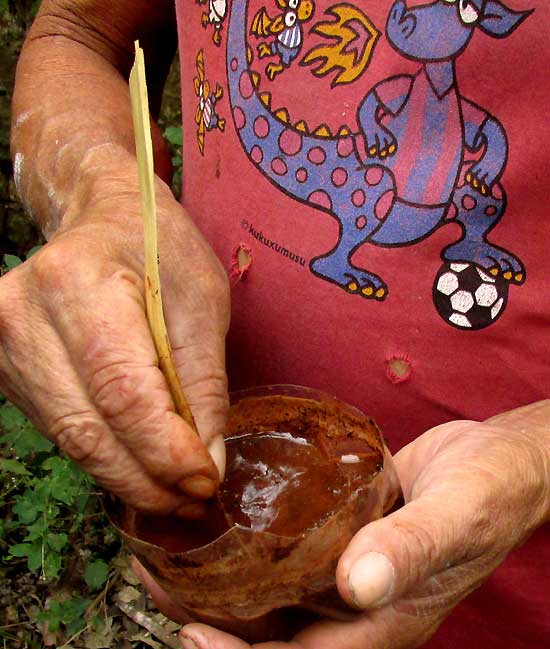
Next Juan formed an applicator from a dry Huano palm frond and smeared the mud over his aching jaw, as shown below:
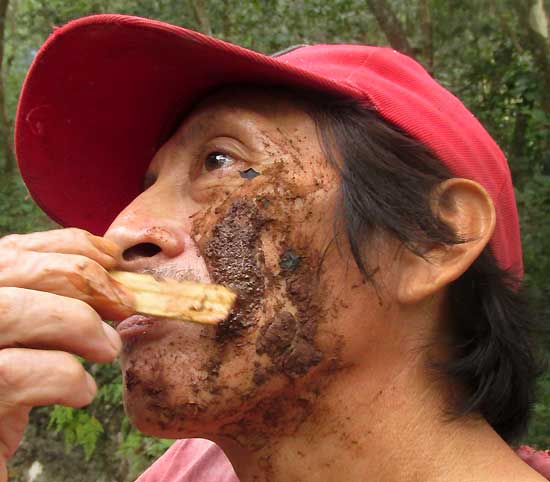
Wikipedia provides an extensive page on "medicinal clay," which is what Juan's ant-mud was, at https://en.wikipedia.org/wiki/Medicinal_clay
On that page, among topics covered are trace minerals made available by clay applied to the skin or ingested; of mud or wet clay poultices applied to the body to treat infections, indigestion and other problems; of various kinds of clay that used to be sold over the counter (Kaopectate was one); the use of Montmorillonite clay for skin conditions, and; much more.
The drying clay produces a cooling sensation that feels good on a toothache-swollen cheek. For a week Juan alternated between his three-herb paste and ant-mound mud, and sometimes used both.
At this writing his pain is gone, the cheek is no longer swollen, and he proudly speaks of his having cured his toothache.